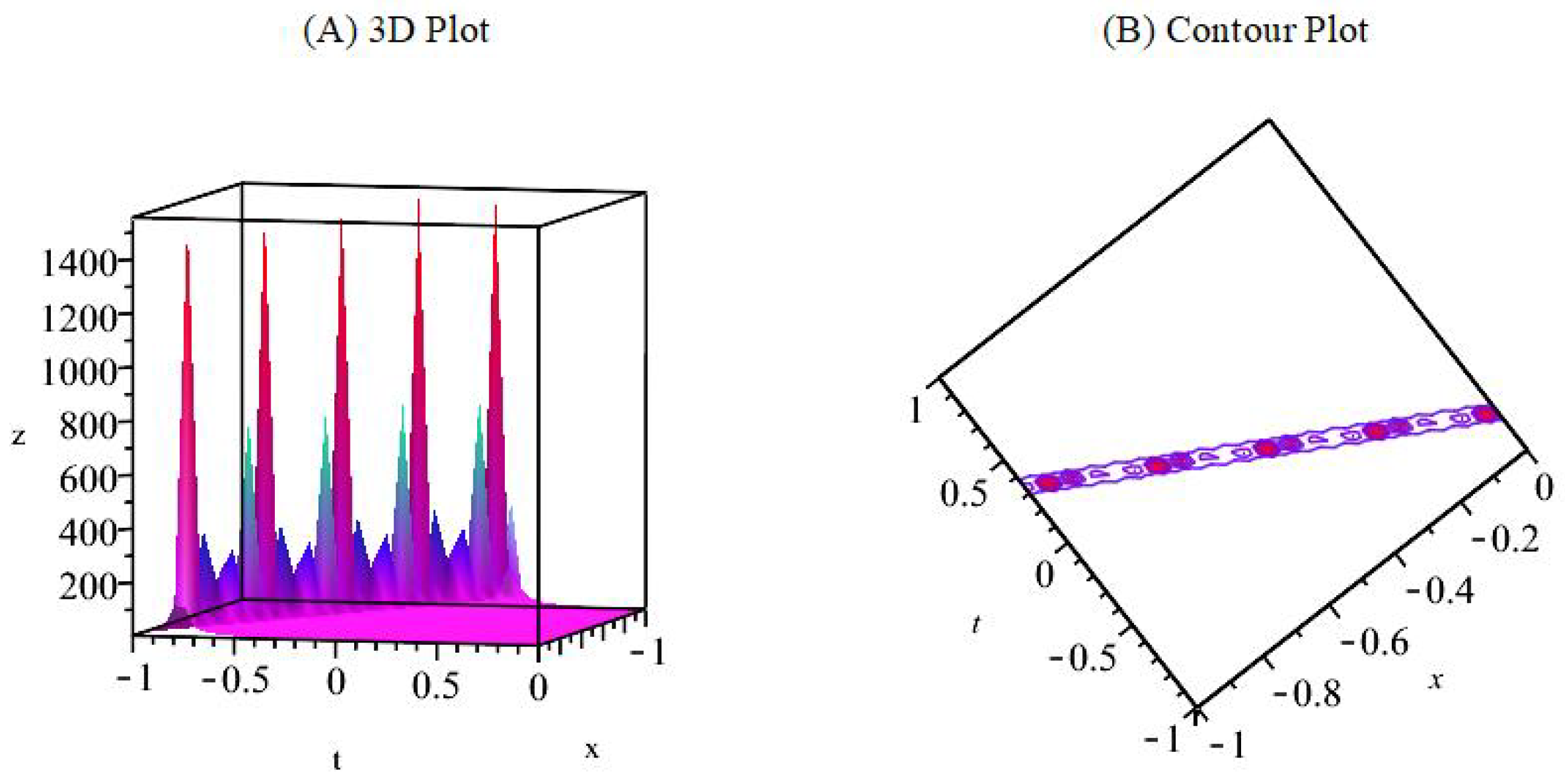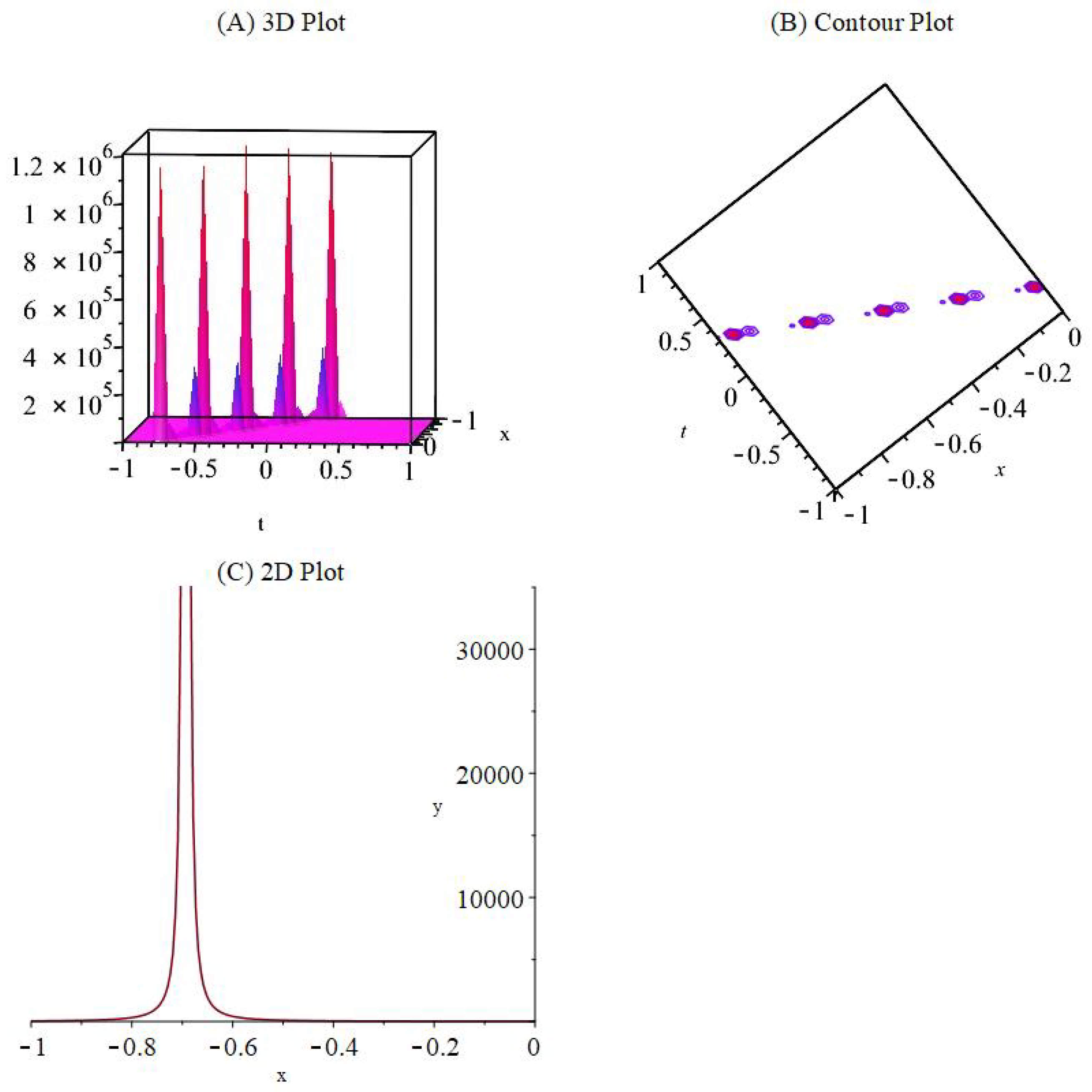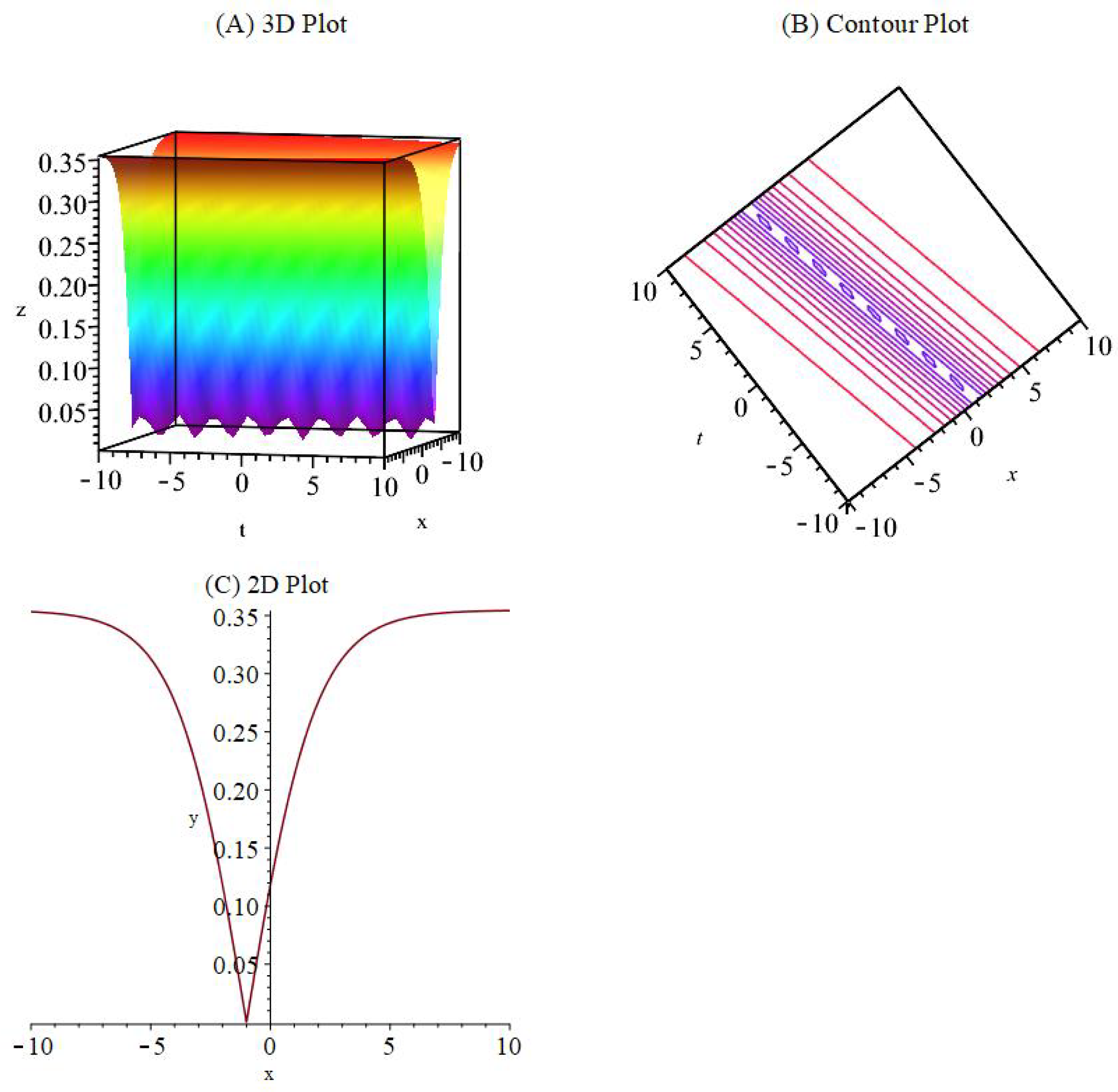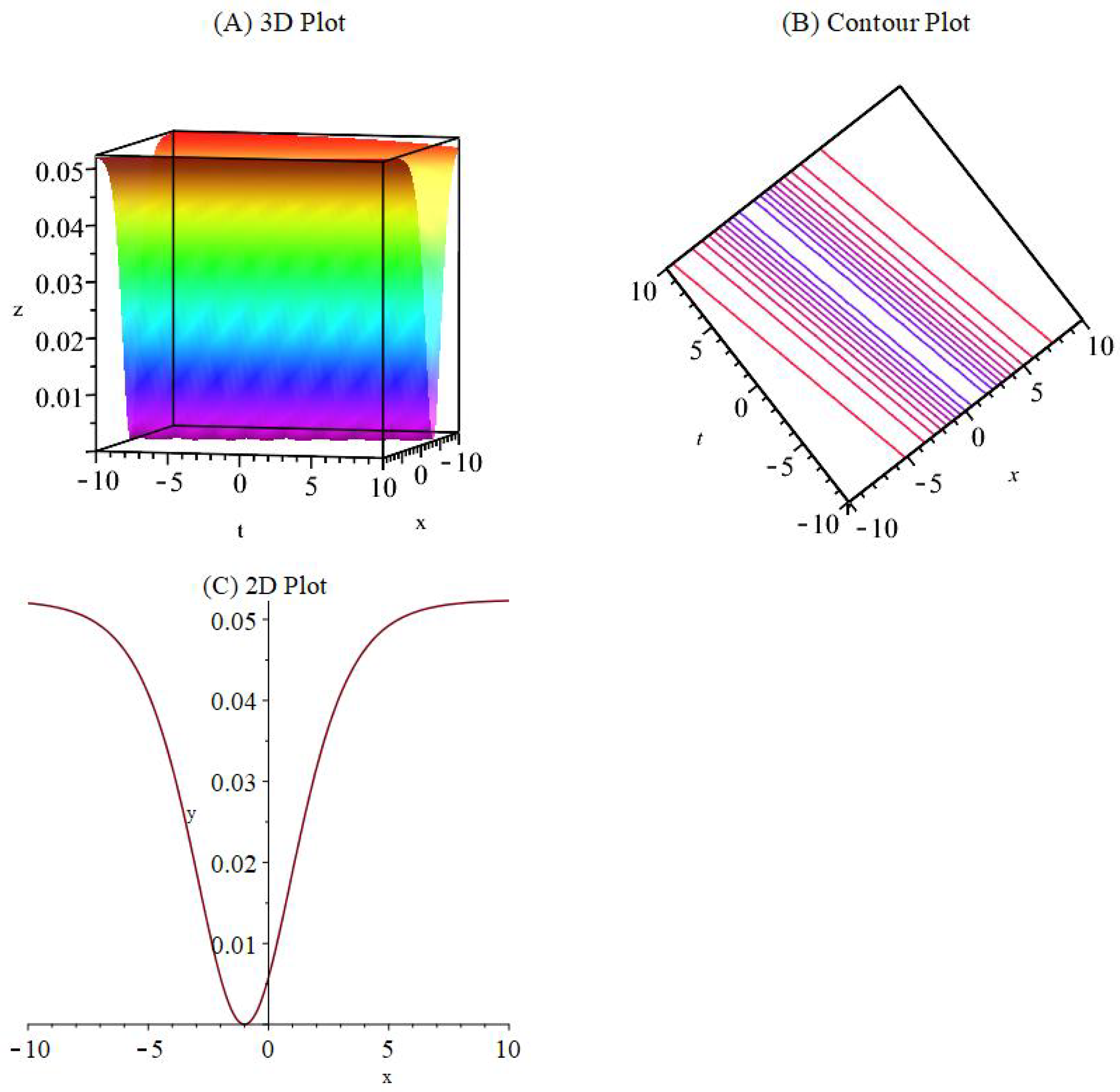New Solitary Wave Patterns of the Fokas System in Fiber Optics
Abstract
1. Introduction
2. Results
2.1. Application of GKP
2.2. Application of MKP
3. Discussion
4. Conclusions
5. Materials and Methods
5.1. Preliminary Information
5.2. The Generalized Kudryashov Procedure
5.3. The Modified Kudryashov Procedure
Author Contributions
Funding
Data Availability Statement
Acknowledgments
Conflicts of Interest
References
- Zahran, E.H.M.; Arqub, O.A.; Bekir, A.; Abukhaled, M. New diverse types of soliton solutions to the Radhakrishnan-Kundu-Lakshmanan equation. AIMS Math. 2023, 8, 8985–9008. [Google Scholar] [CrossRef]
- Zhou, Y.; Zhang, X.; Zhang, C.; Jia, J.; Ma, W.X. New lump solutions to a (3+1)-dimensional generalized Calogero-Bogoyavlenskii-Schiff equation. Appl. Math. Lett. 2023, 141, 108598. [Google Scholar] [CrossRef]
- Hashemi, M.S.; Haji-Badali, A.; Alizadeh, F.; Inc, M. Classical and non-classical Lie symmetry analysis, conservation laws and exact solutions of the time-fractional Chen-Lee-Liu equation. Comput. Appl. Math. 2023, 42, 73. [Google Scholar] [CrossRef]
- Raza, N.; Abdullah, M.A.; Butt, A.R. Analytical soliton solutions of Biswas-Milovic equation in Kerr and non-Kerr law media. Optik 2018, 157, 993–1002. [Google Scholar] [CrossRef]
- Abdel-Aty, A.H.; Raza, N.; Batool, A.; Mahmoud, E.E.; Yahia, I.S.; Yousef, E.S. Pattern Formation of a Bubbly Fluid Mixture under the Effect of Thermodynamics via Kudryashov-Sinelshchikov Model, Hindawi. J. Math. 2022, 2022, 9546205. [Google Scholar] [CrossRef]
- Hosseini, K.; Kumar, D.; Kaplan, M.; Bejarbaneh, E.Y. New exact traveling wave solutions of the unstable nonlinear Schrödinger equations. Commun. Theor. Phys. 2017, 68, 761. [Google Scholar] [CrossRef]
- Kumar, D.; Kaplan, M. Application of the modified Kudryashov method to the generalized Schrödinger-Boussinesq equations. Opt. Quantum Electron. 2018, 50, 329. [Google Scholar] [CrossRef]
- Kumar, S.; Kumar, D.; Kumar, A. Lie symmetry analysis for obtaining the abundant exact solutions, optimal system and dynamics of solitons for a higher-dimensional Fokas equation. Chaos Solitons Fractals 2021, 142, 110507. [Google Scholar] [CrossRef]
- Wang, K.J. Abundant exact soliton solutions to the Fokas system. Optik 2022, 249, 168265. [Google Scholar] [CrossRef]
- Fokas, A.S. On the simplest integrable equation in 2+1. Inverse Probl. 1994, 10, L19. [Google Scholar] [CrossRef]
- Shulman, E.I. On the integrability of equations of Davey-Stewartson type. Teor. Mat. Fiz. 1983, 56, 131–136. [Google Scholar] [CrossRef]
- Chakravarty, S.; Kent, S.L.; Newman, E.T. Some reductions of the self-dual Yang-Mills equations to integrable systems in 2+1 dimensions. J. Math. Phys. 1995, 36, 763–772. [Google Scholar] [CrossRef]
- Rao, J.; He, J.; Mihalache, D. Doubly localized rogue waves on a background of dark solitons for the Fokas system. Appl. Math. Lett. 2021, 121, 107435. [Google Scholar] [CrossRef]
- Rao, J.; Mihalache, D.; Cheng, Y.; He, J. Lump-soliton solutions to the Fokas system. Phys. Lett. A 2019, 383, 1138–1142. [Google Scholar] [CrossRef]
- Chen, T.T.; Hu, P.Y.; He, J.S. General higher-order breather and hybrid solutions of the Fokas system. Commun. Theor. Phys. 2019, 71, 496. [Google Scholar] [CrossRef]
- Tarla, S.; Ali, K.K.; Sun, T.C.; Yilmazer, R.; Osman, M.S. Nonlinear pulse propagation for novel optical solitons modeled by Fokas system in monomode optical fibers. Results Phys. 2022, 36, 105381. [Google Scholar] [CrossRef]
- Wang, K.J.; Liu, J.H.; Wu, J. Soliton solutions to the Fokas system arising in monomode optical fibers. Optik 2022, 251, 168319. [Google Scholar] [CrossRef]
- Alotaibi, M.F.; Raza, N.; Rafiq, M.H.; Soltani, A. New solitary waves, bifurcation and chaotic patterns of Fokas system arising in monomode fiber communication system. Alex. Eng. J. 2023, 67, 583–595. [Google Scholar] [CrossRef]
- Atas, S.S.; Ali, K.K.; Sulaiman, T.A.; Bulut, H. Optical solitons to the Fokas system in monomode optical fibers. Opt. Quantum Electron. 2022, 54, 707. [Google Scholar] [CrossRef]
- Alrebdi, T.A.; Raza, N.; Arshed, S.; Abdel-Aty, A.H. New solitary wave patterns of Fokas-system arising in monomode fiber communication systems. Opt. Quantum Electron. 2022, 54, 712. [Google Scholar] [CrossRef]
- Kichenassamy, S.; Olver, P.J. Exixtence and nonexistence of solitary wave solutions to higher-order model evolution equations. SIAM J. Math. Anal. 1992, 23, 1141–1166. [Google Scholar] [CrossRef]
- Kaplan, M.; Bekir, A.; Akbulut, A. A generalized Kudryashov method to some nonlinear evolution equations in mathematical physics. Nonlinear Dyn. 2016, 85, 2843–2850. [Google Scholar] [CrossRef]
- Kudryashov, N.A. On “new travelling wave solutions” of the KdV and the KdV-Burgers equations. Commun. Nonlinear Sci. Numer. Simul. 2009, 14, 1891–1900. [Google Scholar] [CrossRef]
- Ege, S.M.; Misirli, E. The modified Kudryashov method for solving some fractional-order nonlinear equations. Adv. Differ. Equ. 2014, 2014, 135. [Google Scholar] [CrossRef]
- Kudryashov, N.A. One method for finding exact solutions of nonlinear differential equations. Commun. Nonlinear Sci. Numer. Simul. 2012, 17, 2248–2253. [Google Scholar] [CrossRef]





Disclaimer/Publisher’s Note: The statements, opinions and data contained in all publications are solely those of the individual author(s) and contributor(s) and not of MDPI and/or the editor(s). MDPI and/or the editor(s) disclaim responsibility for any injury to people or property resulting from any ideas, methods, instructions or products referred to in the content. |
© 2023 by the authors. Licensee MDPI, Basel, Switzerland. This article is an open access article distributed under the terms and conditions of the Creative Commons Attribution (CC BY) license (https://creativecommons.org/licenses/by/4.0/).
Share and Cite
Kaplan, M.; Akbulut, A.; Alqahtani, R.T. New Solitary Wave Patterns of the Fokas System in Fiber Optics. Mathematics 2023, 11, 1810. https://doi.org/10.3390/math11081810
Kaplan M, Akbulut A, Alqahtani RT. New Solitary Wave Patterns of the Fokas System in Fiber Optics. Mathematics. 2023; 11(8):1810. https://doi.org/10.3390/math11081810
Chicago/Turabian StyleKaplan, Melike, Arzu Akbulut, and Rubayyi T. Alqahtani. 2023. "New Solitary Wave Patterns of the Fokas System in Fiber Optics" Mathematics 11, no. 8: 1810. https://doi.org/10.3390/math11081810
APA StyleKaplan, M., Akbulut, A., & Alqahtani, R. T. (2023). New Solitary Wave Patterns of the Fokas System in Fiber Optics. Mathematics, 11(8), 1810. https://doi.org/10.3390/math11081810






